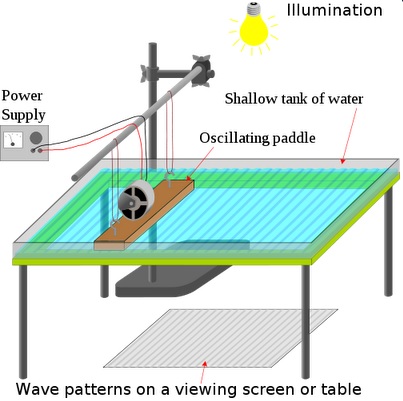Table of Contents
Ripple Tank
The ripple tank serves as a fundamental apparatus in physics laboratories, particularly in the study of wave mechanics. Its design and functionality make it an invaluable tool for illustrating various wave properties and phenomena. Comprising a shallow tray filled with water, a transparent base, a light source positioned directly above, and a white screen beneath, the ripple tank provides a visual representation of water waves and their behavior.
One of the key applications of the ripple tank is the demonstration of wave properties such as reflection and refraction. By utilizing a straight dipper, researchers can generate straight waves in the tank, allowing for the observation and analysis of how these waves reflect off boundaries or refract when passing through different mediums within the tank. The ripple tank’s versatility extends to the creation of circular waves as well, achieved through the use of a spherical dipper. This feature enables the investigation of circular wave patterns and their characteristics.
To set the waves in motion, both dippers are vibrated up and down by a motor, ensuring a controlled and consistent generation of waves. As the waves propagate across the water surface, they create alternating bright and dark patches on the white screen beneath the tray. These patches serve as a visual representation of the wave characteristics, indicating the position of crests and troughs. The dark patches correspond to the crests of the waves, while the bright patches signify the troughs.
In essence, the ripple tank provides a tangible and observable platform for students and researchers to explore wave phenomena in a controlled environment. Its ability to create different types of waves and showcase their interactions makes it an essential tool for teaching and understanding fundamental principles of wave mechanics, laying the foundation for further exploration in the field of physics.
Why Does The Dark Patches Correspond To The Crests And Bright Patches Correspond To The Troughs?
Click here to show/hide answer
Light is absorbed/scattered as it passes through a body of water. At a crest, the light has to travel a longer distance through the water, which will cause more light to be absorbed/scattered. This will cause crests to appear as dark patches. The opposite logic applies to the troughs. At a trough, the light travels a shorter distance through the water, which causes less light to be absorbed/scattered. This causes troughs to appear as bright patches.
Video Of A Ripple Tank In Action
Further Readings On Ripple Tank
Frequency and Amplitude Control
One of the distinctive features of ripple tanks lies in their ability to afford precise control over the fundamental characteristics of generated waves. Through systematic adjustments, researchers can manipulate both the frequency and amplitude of the waves produced within the tank. By varying the frequency of the motor that drives the dippers, the number of waves generated per unit of time can be finely tuned. Simultaneously, changes in amplitude, representing the magnitude of the vibrations, influence the height of the waves. This level of control allows for systematic exploration and analysis, empowering students and researchers to delve into the intricate relationships between frequency, amplitude, and the resulting wave patterns, fostering a deeper understanding of wave mechanics.
Wave Interference
The ripple tank serves as a captivating arena for the visualization of wave interference phenomena. As waves propagate through the water surface, they encounter each other, leading to instances of constructive and destructive interference. Through the interplay of overlapping waves, students can witness the formation of intricate interference patterns on the screen beneath the tank. Constructive interference results in reinforcement, producing regions of heightened wave amplitude, while destructive interference leads to cancellation, manifesting as areas with diminished or no wave activity. This hands-on exploration of interference not only solidifies theoretical concepts but also provides a tangible and memorable experience, allowing learners to grasp the dynamic nature of wave interactions.
Wavelength Measurement
A fundamental aspect of wave mechanics explored in ripple tanks is the measurement of wavelength. The tank facilitates a direct and tangible approach to quantifying the distance between successive crests or troughs of the generated waves. By utilizing the observed wave patterns on the screen below the tank, researchers can make precise measurements, offering a practical demonstration of wavelength concepts. This exercise not only reinforces theoretical knowledge but also provides a crucial bridge between abstract mathematical representations and real-world wave phenomena. The ability to measure wavelength in a controlled environment enhances the educational experience, enabling students to comprehend the relationship between wave speed, frequency, and wavelength with clarity and precision.
Practical Applications Of Ripple Tanks
The insights gained from studying wave mechanics in ripple tanks extend far beyond the confines of the laboratory, finding practical applications in diverse scientific disciplines. In the field of seismology, researchers leverage the principles elucidated by ripple tanks to comprehend the behavior of seismic waves propagating through the Earth. The ability to simulate and observe wave interactions aids in deciphering the complex structure of the Earth’s interior, contributing to our understanding of earthquakes and the composition of geological layers.
Oceanography benefits significantly from the study of water waves using ripple tanks. By replicating various wave patterns in controlled environments, scientists gain valuable data for analyzing ocean dynamics. Ripple tanks provide a platform for investigating the impact of different factors, such as wind or underwater topography, on wave behavior. This knowledge proves instrumental in predicting and understanding coastal processes, storm surges, and the overall movement of water bodies, thereby enhancing our ability to manage and respond to environmental changes.
Furthermore, the principles learned from ripple tanks are integral to advancements in telecommunications. Understanding how waves propagate, reflect, and refract allows engineers to design efficient communication systems. The study of wave behavior aids in optimizing signal transmission, reducing interference, and improving the overall reliability of telecommunications networks. In this way, the ripple tank serves as a foundational tool in preparing the next generation of scientists and engineers to tackle real-world challenges across a spectrum of scientific and technological domains.
